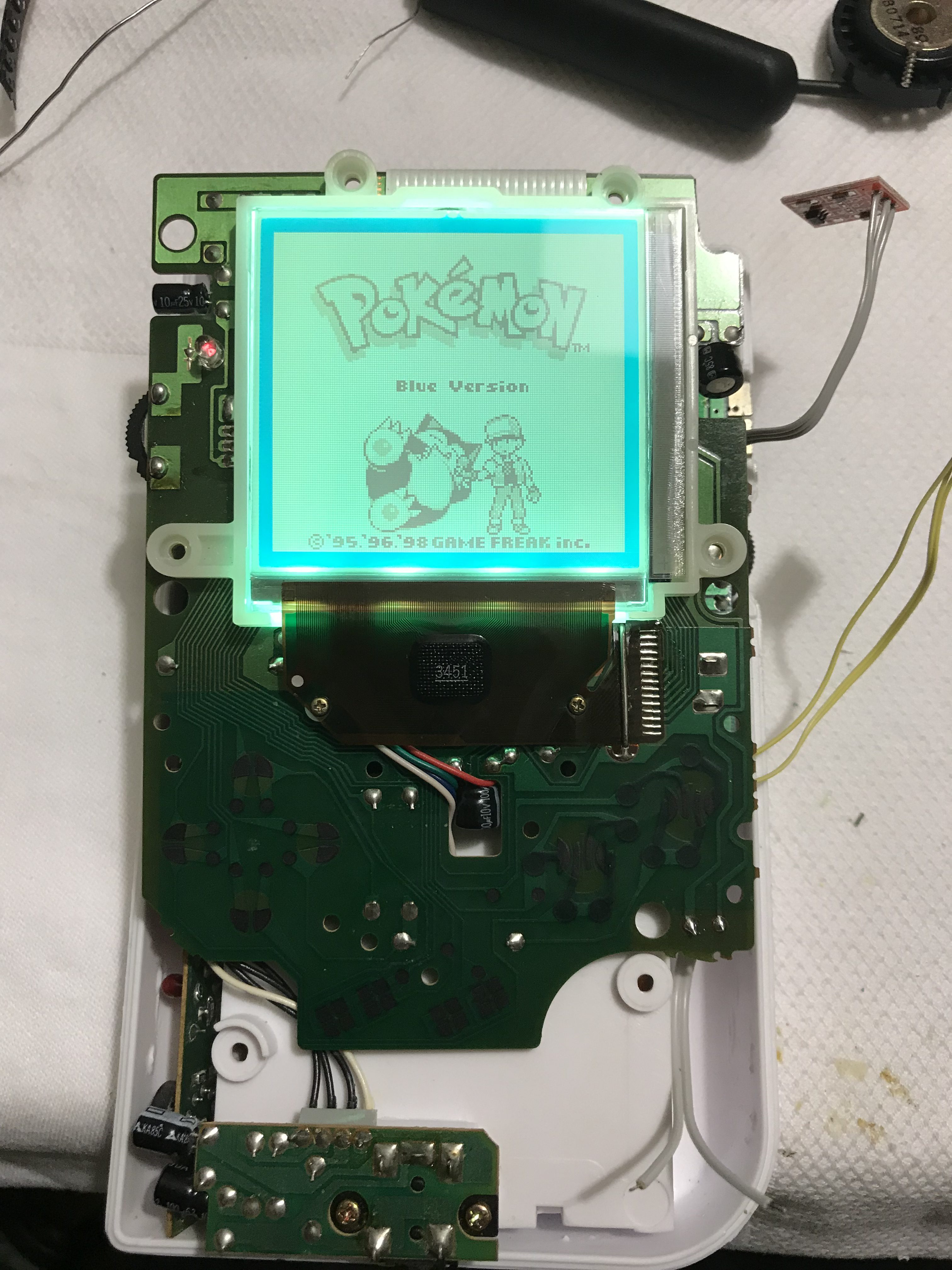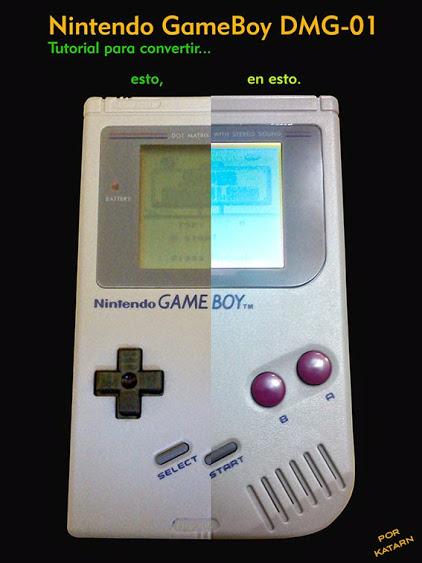Description
How do you play your Gameboy DMG and Gameboy Pocket in the dark? You add a little backlight to it!

Replace your old, broken or cracked LCD screen with this new backlight kit! Make your DMG console display have color!! The advantages of the DMG OSD are as bellow: 1. Built-in 8 color modes, Each 'color mode' can be adjustable. Each color mode can change to 65,536 different colors! The display area is 11% larger th. Refurbished Nintendo DMG-01 Game Boy Gray Bi-Vert, Backlight & Box Glass Screen. $109.99 to $139.99. Gameboy DMG-01 Play It Loud Clear. Tested and Working. Gameboy Dmg-01 Console Bundle/ Lot WORKS READ DISCRIPTION.
This is a slim backlight that fits behind the screen once you have removed the back polarizer off the Gameboy LCD. This backlight requires you to soldier 2 wires (not included) to the backlight and then to the main power capacitor on the LCD motherboard. Its Suggested that you install a Resistor between the wire going to the power side of the of the backlight and the main power capacitor. (This Resistor is included). For best results you will also need to install a bivert chip in the system.
What you get.
Give your Game Boy a second life with our Game Boy backlights. We carry three unique models, each available in a range of colors. With options geared towards modders of all levels of experience, it's never been so easy to light up your favorite DMG! This backlight is compatible with the Nintendo Original Game Boy DMG-01 and Game Boy Pocket. It is NOT compatible with the following models: Game Boy Color, Game Boy Advance, Game Boy Advance SP, Nintendo DS, or Nintendo 3DS.
- Backlight panel
- Polarizer sheet to replace one you removed
- 100 ohm Resistor
**Images are taken with a bivert chip installed. Your results my very from the images we have.**
Introduction: Gameboy Backlight: How to Backlight a Game Boy (DMG)
You can find our backlights at http://retromodding.com
Required Parts:
- ASM Density Backlight
- Philips head Screwdriver
- Smaller Philips head Screwdriver
- Soldering Iron
- Solder
Optional Parts:
- Flux
- Razorblade Wire strippers/cutters
- Rubbing alcohol & cotton swabs (potentially optional)
- Rubber Gloves
For disassembling your Game Boy, visit our guide here: How to Disassemble a Game Boy
Before you begin, assure you have a genuine ASM Density Backlight. Refer to the hologram on the back of the backlight panel and reference the photo above for authenticity. Many of the Density imitations on the market are notorious for overheating the Game Boy's power regulator, causing the case's plastic to melt.
Gameboy Dmg Backlight
Introduction:
The LCD is comprised of four main layers shown in 'Figure 1'.
Our goal is to remove the bottom polarized film (which will be replaced with our own piece) and the reflective foil. DO NOT remove the top layer of polarized film. If you mistakenly remove it, you will not be able to see any data on your LCD screen.
The reflective foil is nontransparent, therefore it needs to be removed for the backlight to be visible. We remove the polarized film as well, because if we do not, there will be a considerable amount of glue residue left on it that is extremely difficult to remove. Furthermore, by using our own piece of polarized film we can 'invert' or 'bivert' the LCD.


Before we begin, we recommend wearing rubber gloves to prevent getting fingerprints on the LCD. We also put a piece of plastic over the front of the LCD to prevent scratches, but this is optional.
Step 1: Lifting the LCD
We need to pry the LCD up to get access to the film that we will be removing. You can get underneath the LCD with a screwdriver or flat object at the lip at the top of the plastic frame around the LCD.
Step 2: Polarized Film and Mirror Film Removal
There are two piece of foam under the LCD that can now be removed.
Take your razor blade and carefully wedge it between the two layers under the glass, just enough so that you can grip them with your fingers. Be cautious not to lift the LCD too high, as the ribbon cable providing the horizontal data may rip!
Once you can grip the film with your hand begin slowly removing it. The difficulty of this step varies from LCD to LCD depending on how active the adhesive is that attaches the film to the glass.
After backlighting hundreds of LCDs ourselves, we have found the most effective way is to pull away from the ribbon cable on the rightmost side. We have indicated the process in the photos above. If you have your own method that you'd like to share, please leave a comment below!
Step 3: After Film Removal
Your LCD should look like this after the film removal process.
Sometimes there is glue residue left on the LCD screen after this process. We use a very high percentage rubbing alcohol and a cotton swab to remove it.
Step 4: Prepping the Backlight
Take your ASM Density Game Boy Backlight to prepare for soldering.
There is a piece of protective clear plastic on top of your backlight kit to protect it from scratches. This can now be removed. Be cautious not to remove a piece of diffusion film. The diffusion film is white. To reiterate, you want to remove a clear piece of plastic. It should take minimal effort to remove.
Step 5: Soldering the Backlight
Solder the two wires that came with the kit to the exposed contacts. They are labeled '+' and '-' to indicate the anode and cathode terminals. The '+' pad connects to the 5v power source on the Game Boy, and the '-' pad connects to ground.
There are several solder points that we can connect to. Conveniently, there is a 5v and a ground source right below the LCD. If you would like to solder here, you will need to strip your wires to the appropriate length. You can eyeball the length by placing the backlight on top of the LCD and placing the wires over top of the solder pads.
Optionally, you can solder directly to the 5v source from the power regulator, and the ground tab at the battery terminals. However, this involves soldering wires from one PCB to the other, and can be a little messy.
Step 6: Positioning the Backlight
Place your backlight into the LCD frame. It should fit comfortably. The innovative design of the Density backlight allows for the solder tab to sit flawlessly above the plastic LCD frame, allowing for an installation with absolutely no cutting!
Remove the protective plastic on both sides of your polarized film, and place it on top of the backlight. View 'Figure 2' for further indication.
Remember, if the replacement polarized film is not inserted, you will not be able to see the image on the LCD!
Step 7: Completion!
Now we need to test if everything looks okay.
Reinsert the front LCD circuit board into the socket on the motherboard. Insert batteries or an AC adapter into the Game Boy and test it out. If everything looks good, you can begin reassembling your Game Boy following the disassembling instructions in reverse. Source: How to Disassemble a Game Boy
Step 8: Troubleshooting
Vertical or Horizontal lines of dead pixels:
If you are experiencing vertical columns of dead pixels, you can view this video on how to repair them:
No image displayed:
- Did you insert the polarized film
- Did you accidentally remove the front film on the LCD?
- Did you rip any ribbon cables during the process?
Step 9: F.A.Q.
F.A.Q.
Will this drain my batteries?
Naturally, adding any electrical components to a device will increase it's power consumption, but the difference is negligible.
Does this work in a Gameboy Color, or Gameboy Advance, etc..?
This backlight will only work with the original Game Boy and the Game Boy Pocket. The Gameboy Color and Game Boy Advance both use LCD technology that can not be backlit. They require frontlighting technology.
I've heard of backlights overheating regulator boards, does the Density backlight cause this problem?
We have never had reports of issues like this because we have properly calculated resistor values. Some of the Density backlight clones on the market have tried to cheaply increase the LED brightness by lowering the resistor value, thus increasing power consumption which will cause symptoms like this.
Gameboy Dmg Backlight
There was no resistor in my package, is this correct?

Yes, this is fine. The resistor is integrated directly into the backlight to make your installation even simpler!
I installed this backlight on a Gameboy Pocket and am experiencing flickering.
We recommend trying to add a resistor of around 47 ohms if you experience this issue. The Game Boy pocket is notorious for power related issues due to Nintendo's choice to use AAA batteries. This will also increase battery life.
Be the First to Share
Recommendations
Gameboy Dmg Backlight Bivert
Game Boy Dmg Ips Backlight V2
Make it Glow Contest
First Time Author Contest
PCB Challenge
